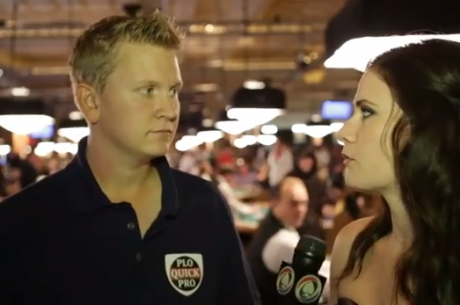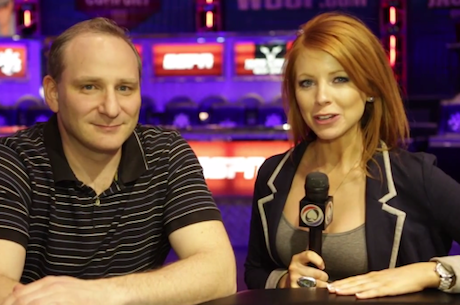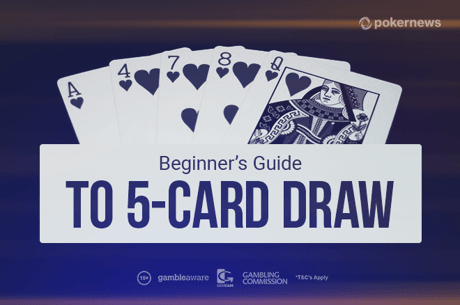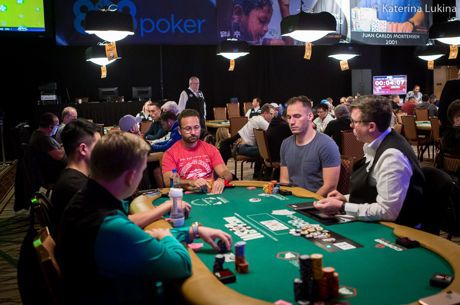No-Limit 2-7 Draw Lowball Strategy with Bracelet Winner Larry Wright
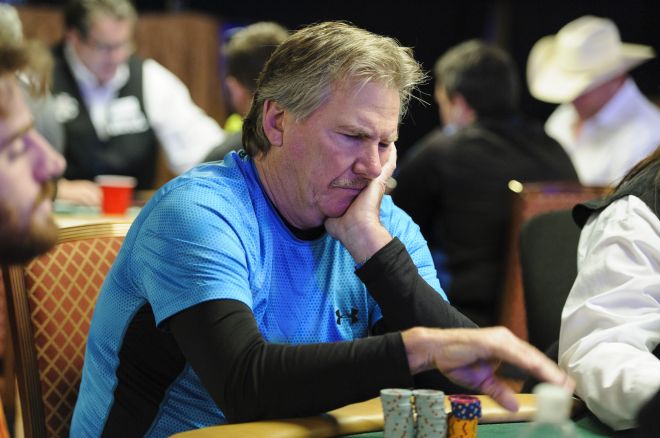
Event #43: $10,000 No-Limit 2-7 Draw Lowball kicked off on Sunday at the 2013 World Series of Poker. No-limit 2-7 is a single-draw poker game where the player with the best low hand wins the pot. Each player is dealt five cards to start, and then has the chance to discard (or replace) any cards in their hands for new cards during the draw round. The best possible hand in 2-7 single draw is 2x3x4x5x7x without having the same suit for all cards, also known as "the wheel." Pairs, straights and flushes all count against you, and aces are high.
PokerNews had a chance to chat with 2012 WSOP bracelet winner Larry Wright to discuss a few concepts of the game. Last year he took down the $1,500 No-Limit 2-7 Draw Lowball event, defeating 284 players including a stacked final table with Brandon Cantu, Andrew Lichtenberger, Michael "The Grinder" Mizrachi and Erick Lindgren.
What is an example of a good drawing hand?
When I am drawing, I want a seven and a deuce in my hand, and I like to know which cards I am throwing away. If I have a pair of sevens or a pair of deuces, then I know I am drawing real live. So the seven-deuce in my hand is very important, but probably more important than that is position. You can raise on the button with a much bigger hand and wait and see what the small and big blind do. That��s how I��ve been playing [in Event #43]; playing position, position, position.
Does your starting range of hands change as you get closer to the button?
It does change, but it depends how many chips you have. If you have a lot of chips, then my range opens wide. I will reraise with some pairs in my hand if I have a pair of fours, deuces, or sevens in my hand.
How many cards are considered too many before deciding to the play the hand?
Let��s say you have 2x7xJxQxKx, I will never play that hand. I will throw it away. I did witness, though, a player throw three cards away on Day 2. That is the first time I��ve seen that done in this tournament. I��ve seen three cards thrown away during lower levels, but never in the later levels. Drawing two cards is a tough draw in itself, so three is definitely tougher to catch. It��s not smart to gamble, so it��s best to just throw it away and pick a better starting hand.
Unless I am the big blind and the button raises me and I am drawing perfect, then I am just throwing the hand away. When I say I am throwing the hand away, I��ve got a seven-five-three or a seven-six-deuce when I throw two cards away to try to catch perfect. A lot of the other players will raise on the button and get caught and end up throwing two away, but still get lucky. The odds are against you to get anything lower than a ten-low when you are drawing two cards.
There is a little bit of luck and I will say, I��ve seen Phil Ivey running real lucky at this event. I��ve had my ten-lows outrun by Ivey who has drawn two cards maybe seven or eight times in the last two days and hit. So he is running a little lucky. He��s lucky he��s still in the tournament. Actually, he just caught an inside on an eight-high draw and caught a six.
Since there are only two betting rounds and no visible community cards, what other ways do you have to gain an edge on your opponents?
One of my favorite moves is when I am first to act with a pat hand like a made nine or a made eight. I look at the card hard and I��ll even pull out one card as if I will be throwing it away and decide to keep it. All the while, my opponent is probably thinking that I stayed with a jack-low or a ten-low. So then, my opponent will usually draw, and if I��ve stayed on an eight-low or a nine-low I will lead out with a donk bet, something big. With them thinking I stayed on a jack-low or worse, I will usually get paid off. In this situation, I get called all the time.
My other favorite play is when I have a made hand in the blinds, and there has been a raise or reraise then I just smooth call to get action. Then I will check the hand and let them bet at me so I can move in on them with a raise or a shove.
What is one way to bluff an opponent, and what type of opponent are you looking to bluff?
[On Day 1], I had three sevens in my hand. I raised under the gun and had two callers. I was first to act so I stood pat and moved all in, with three sevens in my hand. I knew they didn��t have a seven so no one could call me. I��ve built the reputation of playing solid, so I used that to my advantage. I took down a big pot because of that bluff, which turned my day around. A seven is a key card to have so I thought that was a good position to push a bluff. Because I moved all in, an opponent wouldn��t be calling with a made nine or worse.
I watch whether a player draws one or two cards. I watch whether they squeeze the card. I watch whether they organize their cards and place one in the middle; it all matters. Phil Ivey is very hard to read because he never moves his cards around. He just looks at his hand, lays it on the table, and never looks at it again. So it��s very hard to get a read off him. Everyone else places the card where they want it to fit. So I know if they bet they probably hit their draw. If they put it in the middle and then take the same card and put it off to the side then they probably paired. I am very observant, and I know it helps.
When are you most inclined to start hero calling?
I hero called all day yesterday early in the tournament. I was hero calling with a ten-low and it wasn��t working out for me. When you are short-stacked, it isn��t wise to hero call. When you have a big stack you can afford to call more and take risks.
What is one of the biggest mistakes you see opponents make in this game?
Over-betting with a jack-low. I also see a lot of players drawing with a possibility of making a straight with their hand. They tend to draw and catch the straight. I see that a lot, actually.
So then if you start with a straight draw, so you just fold the hand?
That is a tough call because it takes away eight of your outs. I��ve had two straight calls and both times I threw away the middle card. Most people will throw away the top card, but I changed it up and took away the middle card and caught top pair. Either way you look at it, it��s a risk. I wish I hadn��t played the straight draws because it hurt me. When you are short stacked and big blind against small blind, then you have to make that play. I had a 9x8x7x6x5x and threw away the six and caught a nine. If I throw away a nine then I am still catching a nine. I left myself open for the deuce, trey, and ten, which are 12 outs. Sometimes you have to put someone else on a hand, but all in all I think it��s a bad deal drawing to a straight. Early in the tournament it��s probably not as bad, but I think it depends which card you throw away.
Is there any fundamental strategy in this game or is it more luck of the draw?
I��m old school. I saw it all day long, players who raise under the gun, draw one card, and bet. Players tend to play as if they are playing no-limit poker. This game is important to play in position. The button is the most powerful weapon. There is no knowledge other than what you have in your hand and a player��s tendencies. Playing someone out of position is very hard on a drawing hand. On a pat hand it doesn��t really matter where you play from though.
Is there an actual way to calculate your odds on whether you can hit your draw?
I count all the low cards that are available. If there are three people in the hand then I have to take a third of those cards out because they are holding the same cards or they wouldn��t be in the hand. If I have position and I have a jack-low and two players are drawing one or two cards then I have to think real hard if I want to stand pat on that jack because they should have most of my outs. If they are drawing one then there is a good chance my jack will be ok. However, if they draw one and lead then more often than not I can��t call with my jack. Lately, I��ve had to throw away some jacks and paired up so it��s definitely a tough situation.
What are the odds to hit the best hand of them all, 2x3x4x5x7x?
You should hit it one time in a three-day tournament. I hit it once yesterday and that��s it. It doesn��t happen very often. You��ll see a player with an eight-low or a seven-low often but it��s hard to see a 2x3x4x5x7x.
Do you play with a jack-low or a queen-low?
The only way I am playing with a jack early is when I have position and everyone drew two cards. Otherwise, I am throwing the jack away and drawing. Later in the tournament, though, I am standing pat with the hand on the button. Last year, I could have won a second bracelet. I raised on the button with a ten-low. Nick Schulman moved all in and stood pat. I went into the tank and drew a card after throwing away my ten. I missed and he flipped over a jack-ten low. I had the better hand and made the mistake of drawing.
Which game is more difficult, single draw or triple draw?
Single draw is no comparision to triple draw. You will have players in triple draw who draw to their last card in the third draw and lose all their money. There was a girl last year who drew three cards three times and finally hit seven-low and I had an eight-low and was knocked out. I couldn��t protect my hand because it was limit. I think limit is a much easier game. Whereas in no limit, you can protect your hand. I think 2-7 single draw is the purest of all games and the toughest by far.
Be sure to follow our Live Reporting page for continuing coverage of every event at the 2013 World Series of Poker, and follow PokerNews on Twitter for up-to-the-minute news.

